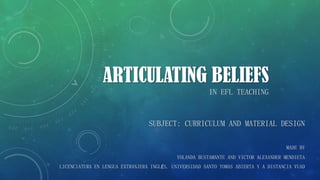
Articulating beliefs
- 1. ARTICULATING BELIEFS IN EFL TEACHING SUBJECT: CURRICULUM AND MATERIAL DESIGN MADE BY YOLANDA BUSTAMANTE AND VICTOR ALEXANDER MENDIETA LICENCIATURA EN LENGUA EXTRANJERA INGLÉS. UNIVERSIDAD SANTO TOMAS ABIERTA Y A DISTANCIA VUAD
- 2. According to the chapter 3 “Articulating Beliefs” from “Designingn Language Courses: A guide for Teachers” by Katheleen Graves, we come accross the following aspects: • VIEW OF LANGUAGE • VIEW OF SOCIAL CONTEXT OF LANGUAGE • VIEW OF LEARNING AND LEARNERS • VIEW OF TEACHING • OTHER IMPORTANT BELIEFS • HOW DO BELIEFS AFFECT THE WAY WEDESIGN A COURSE CONTENT
- 3. Language is our mean of communication, interaction and self-expression. It is rule governed but also changes and develops through the time as fundamental tool we use to structure our social and cultural contexts. Since it is articulated in different ways, according to the context and through different purposes, it constructs our collective thinking and even our reality. Our view of language may differ and it is tied to our beliefs of how the language functions for our own purposes and needs. Based on that, how language should be learnt and what emphasis should be applied when learning it plays a very important role in defining what our view of language is. VIEW OF LANGUAGE
- 4. Language should adjust to the social context where is being used,for that reason social contexts themselves involve linguistic, cultural, political factors, among others. According to this, the language learning and teaching deals also with sociolinguistic, sociocultural and sociopolitical issues. Larson and Smalley (1972) already described culture as a “Blueprint” that “guides the behavior of people in a Community” . That precept leads to deduct that language would not make sense without context because the language develops and can only exist into a certain context. Because of that, the context of a language should be analized to define the nature of language. VIEW OF SOCIAL CONTEXT OF LANGUAGE
- 5. • How language adjusts and functions into the social context. It deals with issues such as whom a messaje is give to (address codes), roles and purposes when communicating and interacting through language. Sociolinguistic • How language adjusts into the culture, which also has to do with habits, customs, social beliefs, attitudes, gender, religión, etc, as well. Sociocultural • How language from a certain social group or community is seen by another one. It deals with how language should be used when participating in the target language`s Community and be aware of how the social system works. Sociopolitical IN ORDER TO ANALYZE CONTEXT OF LANGUAGE, SOCIOLINGUISTIC, SOCIOCULTURAL AND SOCIOPOLITICAL ISSUES SHOULD BE DEFINED AS WELL:
- 6. In this aspect we need to consider first the belief we have about how people learn and the role of a learner. According to Graves, it could be inductive, which is a learning process based on learner self-discovery on his own and as individual or deductive, which is learning collaboratively as a process of acquiring knowledge by means of interaction with others. Learning is a cognitive process that involves important factors such as mental, affective and social needs. Also it involves what is being called multiple intelligences: visual, kinesthetic and auditory (Gardner 1983). Since learners have two different roles: decision makers and also directions followers, there must be an intelligent mixture of both in learning to take place effectively: metacognitive and critical thinking skills. VIEW OF LEARNING AND LEARNERS
- 7. VIEW OF TEACHING It is connected to the view of learning and how learning processes are conceived. Teaching can be seen as a negotiation between learners and teacher about the process of how to acquire knowledge of a certain subject matter. The teacher undertakes a role of transmitter of knowledge and manager of learning process, in which he/she decides how and what to teach through methods and models of learning. Also it is seen as a collaborator, guide and element that orchestrates the learning process but it can not be just on his/her own, it also needs to be conducted by the type of role of learners and how they determine being active their own learning process making decisions as well.
- 8. OTHER IMPORTANT BELIEFS REGARDING CURRICULUM TO TAKE INTO ACCOUNT ARE THE ONES PROVIDED BY DENISE LAWSON: LEARNER-CENTERED CURRICULUM Focuses on learners as active in their own learning process and assessment. They support and collaborate each other MEANING-CENTERED CURRICULUM Sociocultural aspects are also taken into account, as well as the learners particular interests and needs, when it comes to designing the course content. PROCESS-CENTERED CURRICULUM Assessment is being developed by learner, peers, teacher and the participation and performance in different Aspects is also valued. ARTICULATION BETWEEN TEACHER AND LEARNER ROLES.
- 9. . HOW DO BELIEFS AFFECT THE WAY WE DESIGN A COURSE? Since beliefs are thoughts that we keep thinking and are born through experience, they play a fundamental role on every aspect of a human life, especially in education. In this case, in order to design a course, not only the context, which is an external factor, but also the beliefs, which is intrinsic and experiential, determine at every stage what it is going to be implemented for organizing the course and decision to be taken for the content and materials. However, not all beliefs regarding teaching, context or learning are suitable for every course and learner, so it is also important to consider the core beliefs or principles, which are terms implemented by David Markus and Denise Lawson, where it is explained that it is a challenge identifying beliefs most of the times and in order to facilitate its determination, we should clear out their relevance when designing a course by looking for essential beliefs and finding out also when something is missing in the process of teaching and learning to be able to detect that we may probably have uncovered a belief.
- 11. References: Kathleen Graves . (2000). DESIGNING LANGUAGE COURSES: A GUIDE FOR TEACHERS . U.S.A: Heinle & Heinle.